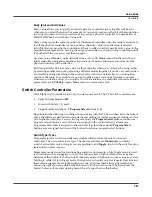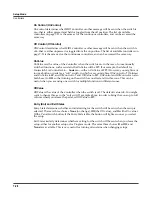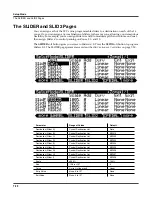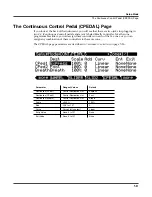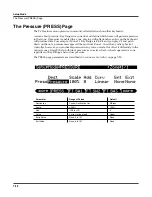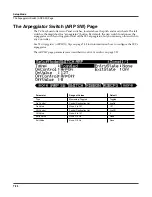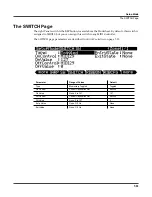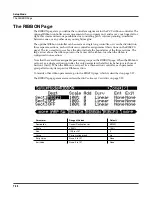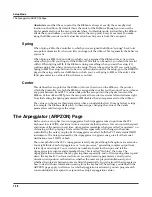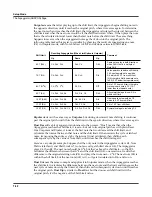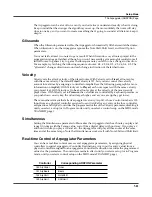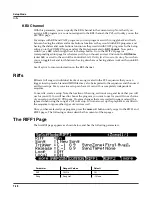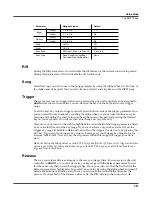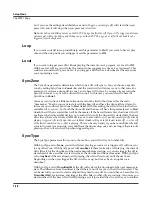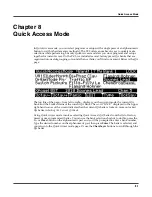
Setup Mode
The Arpeggiator (ARPZON) Page
7-41
Random
plays the currently latched notes in completely random order.
Shuffle
plays them at
random, but keeps track of the notes so that no note repeats until all of the others have played.
Walk
is a “random walk” order: each successive note is either the next or previous note (in
chronological order). For example, suppose you’ve latched four notes—G 4, B 4, D 5, and F 5—
in that order. The first note the Arpeggiator plays is the G 4. The second note will be either B 4
(the next note chronologically), or F 5 (the “previous” note chronologically—that is, the last
latched note). If the second note is B 4, the third note will be either D 5 or G 4. If the second note
is F 5, the third note will be either G 4 or D 5.
Beats
The Beats parameter sets the number of notes per beat. The tempo is based on quarter notes.
Therefore, if you set it to
1/4
, you will get one note per beat of the clock. At
1/16
, you will get
4 notes per beat, and so forth.
Duration
Duration determines how long each arpeggiated note plays.
100%
means that a note sustains
until the next one sounds—very legato.
50%
means that the note fills half the space between
itself and the next note. The lowest value is
1%
—
stacattissimo
. This parameter has no effect on
percussion sounds or other sounds whose duration is fixed.
Note Shift
You can tell the Arpeggiator to transpose all of the currently latched notes each time it plays
through them. Note Shift determines how much transposition will occur for each cycle of notes.
For example, if you have latched C4 and F4, and you assign a Note Shift of 2, the Arpeggiator
will play C4, F4, D4, G4, E4, A4, and so on until it reaches the Shift Limit. The values can range
from
-88
to
88
, with
0
(the default) being no transposition.
Shift Limit
Shift Limit determines how far up or down the Arpeggiator shifts from the original note. The
minimum value is
-60
, and the maximum is
60
. When the Arpeggiator reaches the limit, the
Arpeggiator responds according to the setting for the Limit Option parameter.
Limit Option
This parameter determines what the Arpeggiator does when it has shifted the currently latched
notes up (or down) to the shift limit.
Stop
causes the Arpeggiator to stop when it reaches the
shift limit.
Reset
causes the Arpeggiator to return to its original pitch and repeat the latched
cycle of notes, transposing each cycle according to the settings for Note Shift and Shift Limit. If
the limit allows the notes to go out of MIDI range (for example, if you set Shift to
12
, set the limit
to
60
, and play C6), then those “ghost” notes don’t sound, but they take up rhythmic space: the
Arpeggiator waits for the cycle to play itself out before starting over.
Summary of Contents for PC3
Page 24: ...1 6 Introduction Options ...
Page 50: ...4 4 The Operating Modes Using the Modes ...
Page 174: ...7 54 Setup Mode The Utility Soft Buttons ...
Page 178: ...8 4 Quick Access Mode Making Your Own QA Banks ...
Page 204: ...9 26 Effects Mono Algorithms ...
Page 266: ...A 2 MIDI Implementation Chart ...
Page 308: ...Index x ...

